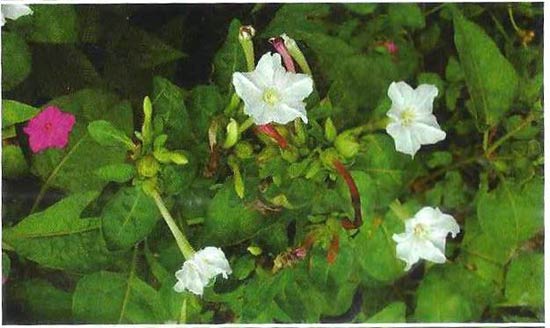The Marvel of Peru, the flower that was time keeper for Kandyans
Robert Knox (1641-1721), author of An Historical Relation of Ceylon, who spent a little over 19 years as a captive on the island made many significant observations in his historic book. Knox’s perceptive powers of observation both on fauna and flora of the country were remarkable.
Writing of how the Kandyans utilised plants for medicinal purposes, he noted, “Nor are they worse supplyed with Medicinal Herbs. The woods are their Apothecaries Shops. …with sometimes there will do
notable Cures.”

Mirablis Jalapa: Illustrated field guide - J.De Vlas (2008)
Of flowers he wrote:“Of flowers they have a great varieties, growing wild, for they plant them not. There are Roses red and white scented like ours: several sorts of sweet smelling flowers, which the young Men and Women gather and tie in their hairs to perfume them; they tie up their hairs in a bunch behind them, and enclose the Flowers therein.”
An astonishing comment is about the flower called the Senderikka that the Kandyans used as a clock. Knox wrote:“There is one Flower deserves to be mentioned for their rarity and use of it, they call it a Sinderic-mal, there are of them some of a Murry colour, and some white. Its Nature is, to open about four a clock in the Evening, and so continue open all Night until the morning, when it closes up itself till four a clock again.
![Portrait-of-Robert-Knox-[White]_P2](https://www.sundaytimes.lk/250824/uploads/Portrait-of-Robert-Knox-White_P2.jpg)
Robert Knox
The botanical nomenclature for this plant is Mirablis Jalapa and the English call it The Marvel of Peru, False Jalap, or more aptly Four o’clock. A native to Peru, it was most likely introduced by the Portuguese to their coastal territories and later spread widely in the hill country.
The first reliable reference to the plant Senderikka on the island can be traced to the German botanist Paul Herman (1646- 1695). While Director of the Dutch Hospital, Colombo from 1672 – 1679, he collected hundreds of plants mainly in the Colombo district. Hermann’s well detailed herbarium (Musaeum Zeylanicum) with notes was published posthumously by the English naturalist William Sherard (1658-1728) in 1717 and 1726 .
This valuable collection reached Carl von Linnaeus, in Upsala, Sweden who revised and published an updated version titled Flora Zeylanica in 1747. It was the first detailed botanical study of an Asian country.
The presence of this plant has been recorded by several eminent botanists over the last four centuries.
George Gardiner (1812-1849), a former Curator of the Royal Botanic Gardens Peradeniya (1844-1848) also notes it in 1848 – “The four o clock plant (Mirablis Jalapa) common about Kandy is a native of Mexico and the West Indies.”
By 1895, Henry Trimen F.R.S. (1843-1896) in his magnum opus on the botany of Sri Lanka ‘A Handbook of the Flora of Ceylon’ (1893), noted:
“Mirablis Jalapa. L.Sendrikka. S. the Marvel of Peru of the English. Is a very common weed in the moist regions. It is native to Peru, but must have been an early introduction to the Old World. Herman has it (Mus.67) under its native name. It occurs with yellow, bright purple, white and striped flowers.
J.C. Willis (1868-1958) refers to the plant in his book ‘The Flowering Plants & Ferns of Ceylon’ published in 1911: “Typically, herbalists use all parts of the plant for medicinal purposes. Although some portions of this plant are considered as toxic if it is ingested or touched – it is used extensively by herbalist ayurvedically physicians.”
| Robert Knox’s seminal work | |
| Robert Knox was just 16 years old when he first went on board the Anne, captained by his father Robert Knox Snr., sailing to India in January 1658. On its return journey in November 1659, the Anne ran into a severe storm off the coast of Trincomalee near Kodiyar Bay that damaged its mast. While on shore searching for a replacement, 17 members of the crew including Knox and his father were taken captive by Rajasinghe II, King of Kandy who had by then a menagerie of prisoners – sailors of Dutch, English and French origin who had inadvertently stepped ashore.Knox was moved inland and held in several remote village sites including Nillambe, Etyagalle and Eladetta and finally to Bandara Koswatte. It was at the latter place that Knox and his friend Stephen Rutland made good their escape. They reached the coastal fort Arrippu on the northwest then under the administration of the V.O.C.(Dutch East India Company) without mishap and after a brief stay as guests of the Governor of Colombo, were dispatched to Batavia (Indonesia) and then later onward to London on an English ship. It was while on his voyage back to England after almost two decades on the island, that Knox wrote up his notes of his adventures in captivity. On arrival in London, he was introduced by his cousin to Robert Hooke (1635-1703), the secretary of the newly founded Royal Society, at a coffee shop and encouraged by Hooke and the President Sir Christopher Wren (1632-1723) to publish his work. Published by the Royal Society’s printer Robert Chiswell, the book was an immediate success. The King of England Charles II (1630-1685) had a special audience with Knox and encouraged him to publish a second edition. ‘An Historical Relation of Ceylon’ was greeted with enthusiasm by the European literati and translated into German (1689), French (1693) and Dutch (1698). Very rarely had a book on Sri Lanka of that period received such a reception. Simple in style, it was a mine of information on the social structure of a society that remained unchanged for centuries. Virtually every book in the Dutch period of administration and other German and British authors from the same period borrowed liberally from Knox’s work. Works of the Dutch period namely Von de Bahr (1688), Hereport (1669), Schweitzer (1682), Fryke (1692), Heydt (1744), Wintergerst (1712), Guyard (1763), Falck (1767), Ives (1773), and Jonville (1800) did so, even several authors of the British period of rule between 1796-1948, some with little acknowledgement. Knox’s work also had considerable influence on English fiction. The greatest novelist of the 17th century Daniel Defoe (1660-1731), drew much from Knox’s writings. Defoe’s novels Robinson Crusoe (1719) and Captain Singleton (1720) both published just a few years before Knox’s death were largely based on Knox’s experience as a captive. In a list of books published at the auction of Defoe’s library, was a copy of Knox’s work. Among the Lankan authors Dr. R.L. Spittel (1851-1969) was one who, no doubt, was influenced by Knox in fashioning his main characters and their adventures as seen in his books ‘Where the White Sambur Roams’ (1951) and ‘Wild White Boy’ (1958).
|
Searching for an ideal partner? Find your soul mate on Hitad.lk, Sri Lanka's favourite marriage proposals page. With Hitad.lk matrimonial advertisements you have access to thousands of ads from potential suitors who are looking for someone just like you.


